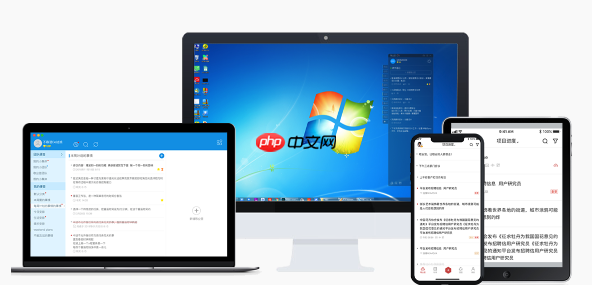利用dism和unattend.xml实现windows无人值守自动安装,需按以下步骤操作:1. 准备工作包括获取windows安装镜像、安装windows adk、准备pe环境及文本编辑器;2. 使用windows sim或手动创建unattend.xml文件,配置自动分区、产品密钥、计算机名、用户账户、时区、语言、驱动程序和更新路径等关键参数;3. 提取install.wim文件并放置到可访问位置;4. 启动至pe环境并使用dism命令应用镜像;5. 使用bcdboot创建启动项;6. 将unattend.xml复制到系统盘的c:\windows\panther目录;7. 重启系统完成自动安装。网络配置可在unattend.xml的specialize和oobesystem阶段通过设置microsoft-windows-tcpip组件实现静态ip或启用dhcp。应用程序可通过synchronouscommand、runsynchronous、脚本或chocolatey在安装过程中静默部署。常见错误如unattend.xml语法错误、找不到install.wim、磁盘分区失败、驱动或应用安装异常等,应检查文件语法、路径、分区配置、驱动兼容性、安装参数及网络设置,并通过日志文件调试定位问题。

简单来说,利用命令行实现Windows无人值守自动安装,核心在于使用DISM和Unattend.xml应答文件。DISM用于镜像管理,Unattend.xml则定义了安装过程中的所有配置。

解决方案
准备工作:

DISM工具。Unattend.xml)。创建Unattend.xml应答文件:
这是无人值守安装的关键。可以使用Windows SIM(System Image Manager,包含在Windows ADK中)图形化创建,也可以手动编写。Unattend.xml文件包含以下关键配置:

一个简单的Unattend.xml示例(仅包含自动分区和计算机名设置):
<?xml version="1.0" encoding="utf-8"?>
<unattend xmlns="urn:schemas-microsoft-com:unattend">
<settings pass="windowsPE">
<component name="Microsoft-Windows-Setup" processorArchitecture="amd64" publicKeyToken="31bf3856ad364e35" language="neutral" versionScope="nonSxS" xmlns:wcm="http://schemas.microsoft.com/WMIConfig/2002/State" xmlns:xsi="http://www.w3.org/2001/XMLSchema-instance">
<DiskConfiguration>
<Disk wcm:action="add">
<DiskID>0</DiskID>
<WillWipeDisk>true</WillWipeDisk>
<CreatePartitions>
<CreatePartition wcm:action="add">
<Type>Primary</Type>
<Size>300</Size>
<Order>1</Order>
</CreatePartition>
<CreatePartition wcm:action="add">
<Type>Primary</Type>
<Order>2</Order>
<Extend>true</Extend>
</CreatePartition>
</CreatePartitions>
</Disk>
</DiskConfiguration>
<ImageInstall>
<OSImage>
<InstallFrom>
<Path>sources\install.wim</Path>
<Index>1</Index>
</InstallFrom>
<InstallTo>
<DiskID>0</DiskID>
<PartitionID>2</PartitionID>
</InstallTo>
</OSImage>
</ImageInstall>
<AutomateOOBE>
<HideEULAPage>true</HideEULAPage>
<HideOEMRegistrationScreens>true</HideOEMRegistrationScreens>
<UserLocale>zh-CN</UserLocale>
</AutomateOOBE>
</component>
</settings>
<settings pass="oobeSystem">
<component name="Microsoft-Windows-Shell-Setup" processorArchitecture="amd64" publicKeyToken="31bf3856ad364e35" language="neutral" versionScope="nonSxS" xmlns:wcm="http://schemas.microsoft.com/WMIConfig/2002/State" xmlns:xsi="http://www.w3.org/2001/XMLSchema-instance">
<ComputerName>AUTOWIN</ComputerName>
<TimeZone>China Standard Time</TimeZone>
</component>
</settings>
<cpi:offlineImage cpi:source="wim:d:/sources/install.wim#Windows 10 Pro" xmlns:cpi="urn:schemas-microsoft-com:cpi" />
</unattend>注意: install.wim的路径和索引需要根据实际情况修改。
准备安装镜像:
将Windows安装镜像(ISO文件)中的install.wim文件提取出来,放到PE环境中可以访问到的位置。
启动到PE环境:
使用U盘或其他方式启动到PE环境。
执行安装命令:
在PE环境下,使用DISM命令应用Unattend.xml文件进行安装。
DISM /Apply-Image /ImageFile:<install.wim路径> /Index:<镜像索引> /ApplyDir:<安装目标分区>
例如:
DISM /Apply-Image /ImageFile:D:\sources\install.wim /Index:1 /ApplyDir:C:\
然后,使用bcdboot命令创建启动项:
bcdboot C:\Windows /s <启动分区盘符> /f UEFI
例如:
bcdboot C:\Windows /s S: /f UEFI
最后,将Unattend.xml复制到系统盘的C:\Windows\Panther目录下。
重启系统:
重启计算机,系统将按照Unattend.xml中的配置自动完成安装。
在Unattend.xml中配置网络,主要涉及到OOBE阶段的设置。需要在specialize和oobeSystem两个阶段进行配置。
配置静态IP地址:
需要指定IP地址、子网掩码、网关和DNS服务器。这需要在specialize阶段的Microsoft-Windows-TCPIP组件中进行配置。
<component name="Microsoft-Windows-TCPIP" processorArchitecture="amd64" publicKeyToken="31bf3856ad364e35" language="neutral" versionScope="nonSxS" xmlns:wcm="http://schemas.microsoft.com/WMIConfig/2002/State" xmlns:xsi="http://www.w3.org/2001/XMLSchema-instance">
<Interfaces>
<Interface wcm:action="add">
<Identifier>以太网</Identifier>
<Ipv4Settings>
<Dhcp>false</Dhcp>
<RouterDiscovery>Disabled</RouterDiscovery>
</Ipv4Settings>
<UnicastIpAddress wcm:action="add">
<Address>192.168.1.100</Address>
<SubnetMask>255.255.255.0</SubnetMask>
</UnicastIpAddress>
<DNSServerSearchOrder wcm:action="add">
<Order>1</Order>
<Address>8.8.8.8</Address>
</DNSServerSearchOrder>
<DNSServerSearchOrder wcm:action="add">
<Order>2</Order>
<Address>114.114.114.114</Address>
</DNSServerSearchOrder>
</Interface>
</Interfaces>
<Routes>
<Route wcm:action="add">
<Identifier>默认网关</Identifier>
<Metric>10</Metric>
<Destination>0.0.0.0</Destination>
<SubnetMask>0.0.0.0</SubnetMask>
<Gateway>192.168.1.1</Gateway>
</Route>
</Routes>
</component>注意: 需要将<Identifier>替换为实际的网络适配器名称。可以使用Get-NetAdapter PowerShell命令查看网络适配器名称。
启用DHCP自动获取IP地址:
将<Dhcp>设置为true即可。
<component name="Microsoft-Windows-TCPIP" processorArchitecture="amd64" publicKeyToken="31bf3856ad364e35" language="neutral" versionScope="nonSxS" xmlns:wcm="http://schemas.microsoft.com/WMIConfig/2002/State" xmlns:xsi="http://www.w3.org/2001/XMLSchema-instance">
<Interfaces>
<Interface wcm:action="add">
<Identifier>以太网</Identifier>
<Ipv4Settings>
<Dhcp>true</Dhcp>
<RouterDiscovery>Disabled</RouterDiscovery>
</Ipv4Settings>
</Interface>
</Interfaces>
</component>在无人值守安装过程中安装应用程序,有几种常见的方法:
使用SynchronousCommand:
这是最常用的方法。在Unattend.xml文件的oobeSystem阶段,可以使用SynchronousCommand来执行安装命令。
<component name="Microsoft-Windows-Shell-Setup" processorArchitecture="amd64" publicKeyToken="31bf3856ad364e35" language="neutral" versionScope="nonSxS" xmlns:wcm="http://schemas.microsoft.com/WMIConfig/2002/State" xmlns:xsi="http://www.w3.org/2001/XMLSchema-instance">
<SynchronousCommand wcm:action="add">
<Order>1</Order>
<CommandLine>cmd /c D:\Software\setup.exe /silent</CommandLine>
<Description>安装应用程序</Description>
<RequiresUserInput>false</RequiresUserInput>
</SynchronousCommand>
</component>注意: /silent参数是静默安装的关键,需要根据应用程序的安装程序支持的参数进行调整。
使用RunSynchronous:
RunSynchronous与SynchronousCommand类似,但可以指定运行用户。
<RunSynchronous wcm:action="add">
<Order>1</Order>
<Path>cmd /c D:\Software\setup.exe /silent</Path>
<Description>安装应用程序</Description>
<RequiresUserInput>false</RequiresUserInput>
</RunSynchronous>使用脚本:
可以将安装命令写入脚本(例如install.bat或install.ps1),然后在Unattend.xml中调用脚本。
<SynchronousCommand wcm:action="add">
<Order>1</Order>
<CommandLine>cmd /c D:\Software\install.bat</CommandLine>
<Description>运行安装脚本</Description>
<RequiresUserInput>false</RequiresUserInput>
</SynchronousCommand>脚本内容示例 (install.bat):
@echo off D:\Software\app1.exe /silent D:\Software\app2.msi /qn
注意: 使用脚本可以更灵活地处理复杂的安装逻辑。
使用 Chocolatey 或其他包管理器:
如果需要在安装过程中安装大量的应用程序,可以使用 Chocolatey 等包管理器。需要在Unattend.xml中安装 Chocolatey,然后使用 Chocolatey 安装应用程序。
<SynchronousCommand wcm:action="add">
<Order>1</Order>
<CommandLine>powershell -ExecutionPolicy Bypass -Command "iex ((New-Object System.Net.WebClient).DownloadString('https://chocolatey.org/install.ps1'))"</CommandLine>
<Description>安装 Chocolatey</Description>
<RequiresUserInput>false</RequiresUserInput>
</SynchronousCommand>
<SynchronousCommand wcm:action="add">
<Order>2</Order>
<CommandLine>choco install <应用程序名称> -y</CommandLine>
<Description>使用 Chocolatey 安装应用程序</Description>
<RequiresUserInput>false</RequiresUserInput>
</SynchronousCommand>无人值守安装过程中可能会遇到各种错误,以下是一些常见错误及解决方法:
Unattend.xml语法错误:
Unattend.xml文件存在语法错误,例如标签未闭合、属性值错误等。Unattend.xml文件,确保语法正确。可以使用Windows SIM加载Unattend.xml文件,它可以检测语法错误。找不到install.wim文件:
DISM命令中指定的install.wim文件路径不正确,或者文件不存在。install.wim文件路径是否正确,确保文件存在。磁盘分区错误:
Unattend.xml文件中的磁盘分区配置,确保分区大小和类型正确。如果使用GPT分区,需要创建EFI系统分区和MSR分区。驱动程序安装失败:
应用程序安装失败:
网络配置错误:
Unattend.xml文件中的网络配置,确保IP地址、子网掩码、网关和DNS服务器正确。可以尝试启用DHCP自动获取IP地址。OOBE阶段卡住:
Unattend.xml文件配置不完整,或者存在冲突。Unattend.xml文件,确保所有必要的配置都已设置。可以尝试删除Unattend.xml文件,手动完成OOBE阶段。调试技巧:
setupact.log和setuperr.log文件: 这些文件位于C:\Windows\Panther目录下,记录了安装过程中的详细信息,可以帮助定位错误。Unattend.xml文件,逐步添加配置,每次添加配置后都进行测试,以便快速定位错误。记住,无人值守安装是一个迭代的过程,需要不断尝试和调试才能找到最佳的配置。
以上就是如何利用命令行实现Windows系统的无人值守自动安装流程的详细内容,更多请关注php中文网其它相关文章!

每个人都需要一台速度更快、更稳定的 PC。随着时间的推移,垃圾文件、旧注册表数据和不必要的后台进程会占用资源并降低性能。幸运的是,许多工具可以让 Windows 保持平稳运行。




Copyright 2014-2025 https://www.php.cn/ All Rights Reserved | php.cn | 湘ICP备2023035733号